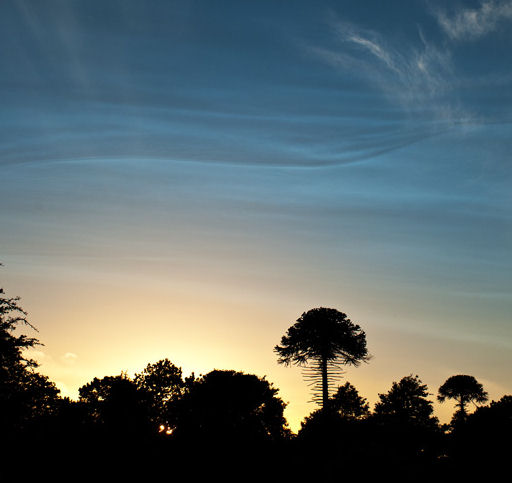GEOMAGNETIC STORM: A sharp gust of solar wind hit Earth's magnetic field at approximately 20:30 UT on June 4th, sparking a G2-class geomagnetic storm. The storm is subsiding now, albeit slowly; high-latitude sky watchers should remain alert for auroras. Aurora alerts: text, voice.
Aurora Images: from Salllie Carlson of Lutsen, Minnesota, USA; from Boutin Gillesof St-Michel de Bellechasse Québec Canada; from Dirk Miller of Rice Lake, Wisconsin; from Noah Weston of Madison, Maine, USA; from Dominic Cantin of Québec city, Québec, Canada.
NOCTILUCENT CLOUDS OVER EUROPE: The 2011 noctilucent cloud (NLC) season has begun. For the past few nights, observers across northern Europe have spotted velvety, electric-blue tendrils rippling across the sunset sky. John Houghton sends this picture from Newtown Linford, Leicester, UK:
"This was the best display of noctilucent clouds I've seen to date," he says. "It was visible even before sunset."
NLCs are a summertime phenomenon. In the upper atmosphere, 80+ km high at the edge of space itself, tiny ice crystals nucleate around microscopic meteoroids and other aerosols; when the crystals catch the rays of the setting sun, they glow electric blue. Ironically, these highest and coldest of clouds form during the warmest months on the ground.
Noctilucent clouds first appeared in the 19th century after the eruption of super-volcano Krakatoa. At the time, people thought the clouds were caused by the eruption, but the clouds persisted long after Krakatoa's ash settled. In those early days, NLCs were a polar phenomenon, mainly seen in far-northern places such as Scandinavia or Alaska. In recent years they have intensified and spread with sightings as far south as Utah and Colorado. A NASA spacecraft named AIM is in orbit to investigate.
Readers, especially you at high latitudes, be alert for NLCs in the evenings ahead. Observing tips may be found in our 2009 Noctilucent Cloud Gallery.
More Images: from Martin McKenna of Maghera, Co. Derry, N. Ireland; from Jesper Gronne of Silkeborg Denmark; from Paul Martin of Pigeon Top, Omagh, Northern Ireland; from Martin Stirland of Winterton On Sea, Norfolk, England; from John C McConnell of Maghaberry Northern Ireland.
ON THE EDGE: Amateur astronomers around the world are reporting strong activity on the limb of the sun. "The prominences on June 4th were gigantic," says Mike Borman, who photographed this specimen from his backyard observatory in Evansville, Indiana:
Prominences are clouds of hot plasma held above the stellar surface by unstable magnetic fields. They can shift, subside, surge, and sometimes even explode--almost anything is possible. Readers with solar telescopes are encouraged to monitor developmemnts.
More Images: from Greg Piepol of Rockville, Maryland; from Michael Buxton of Ocean Beach, California; from Monty Leventhal OAM of Sydney. Australia; from Theo Ramakers of Social Circle GA; from John Stetson of Falmouth, Maine; from Cai-Uso Wohler of Bispingen, Germany.
Provided by Space Weather News

